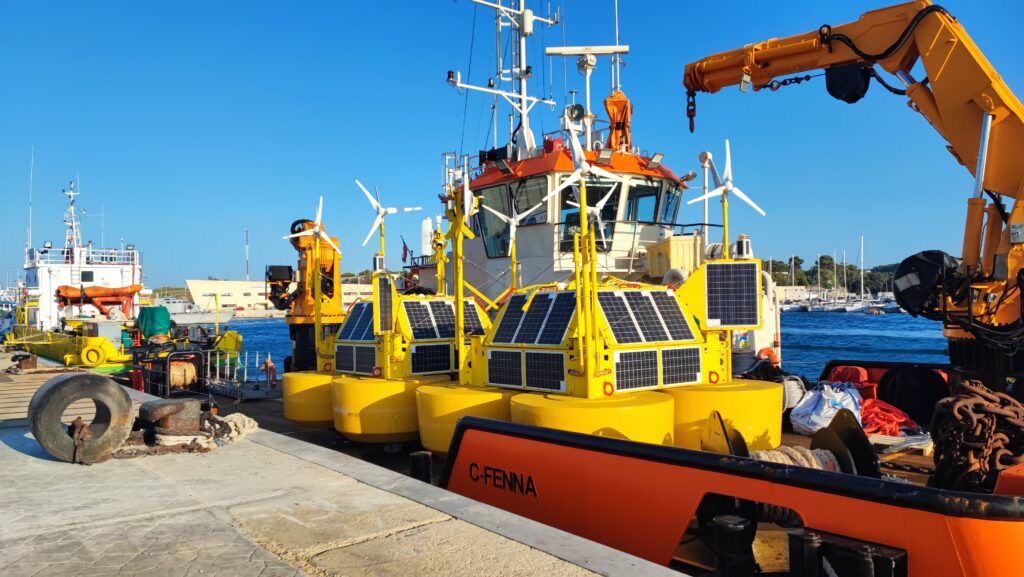Operation carried out thanks to the collaboration between Renantis-BlueFloat Energy and Gruppo Hope-Galileo
Brindisi, 24 July 2023 – A floating buoy housing a ‘Lidar’ (Light Detection and Ranging) and other sensors has been positioned in waters off the coast of Brindisi to conduct necessary surveys and preparations for the construction of the Kailia Energia and Lupiae Maris floating offshore wind farms. The buoy was placed thanks to the collaboration between the companies that, in partnership, are promoting the construction of the two wind farms respectively : Renantis and BlueFloat Energy for Kailia Energia, and Gruppo Hope and Galileo for Lupiae Maris.
Equipped with fully autonomous remote sensing devices, the buoy will remain inside the water for a minimum of 12 months to obtain detailed information on the characteristics of the stretch of sea where the floating platforms of the two wind farms will be located. More specifically, the buoy will collect data on wind, weather conditions, and wave motion in the water.

The decision for these two partnerships to collaborate stems from the desire to create positive and proactive synergies between companies that have chosen to invest in Puglia, a region with significant potential for the development of new floating offshore wind technology. The shared goal is to work together in accelerating the country’s energy transition process and contribute to identifying renewable solutions to reduce dependence on foreign energy supplies.
Ksenia Balanda, Managing Director for the Renantis-BlueFloat Energy partnership in Italy, expressed, “The deployment of this buoy at sea represents the first activity that we are developing in collaboration with the joint venture promoting the Lupiae Maris wind farm. We are confident that creating synergies with other operators and pooling different experiences can only benefit the development of such an innovative sector.“
Michele Scoppio, sole director of Gruppo Hope, added, “The initiation of the campaign to measure the wind resource off the coast of the lower Adriatic confirms the progress of the projects and the commitment and determination of its partners to complete the preliminary phases leading to the start of plant construction. Our partnership with Galileo and the collaboration with Renantis-BlueFloat Energy demonstrate how the maturity and professionalism of the companies involved in the offshore wind sector provide fertile ground for building synergies and teamwork to benefit the country’s energy system, efficiently achieving the challenging goals ahead of us.“
Kailia Energia
Kailia Energia is a floating offshore wind farm jointly promoted by Renantis and BlueFloat Energy off the coast between Brindisi and Lecce. The partnership leverages Renantis’ in-depth knowledge of the Italian industry and energy sector, combined with BlueFloat Energy’s unique experience in floating offshore wind energy. The Kailia Energia park, consisting of 78 turbines, will have the capacity to produce 3.5 TWh of clean energy per year, equivalent to the consumption of approximately one million households. The estimated investment for the project is EUR 3.5 billion, creating employment opportunities for around 1,500 people during construction. The proponents have adopted an open and inclusive involvement model that envisions the redistribution of the generated value, aiming to support the host communities on their path of sustainable growth.
Lupiae Maris
Lupiae Maris s.r.l. is a special purpose company established by Galileo, a pan-European platform for renewable energy development, and Gruppo Hope, a holding company active in designing renewable energy and green hydrogen plants. The joint venture’s purpose is to construct an offshore wind farm with a capacity of 525 MW, comprising 35 wind turbines with a capacity of 15 MW each, positioned in the Otranto Channel between Brindisi and Lecce. The plant will be connected to Terna’s National Transmission Grid through the Brindisi station, located near the Cerano power plant. The Project includes specific measures and design expedients to minimize environmental impacts, such as laying the marine pipeline close to the coast and using semi-submerged floating foundations to reduce the occupation of the seabed.



